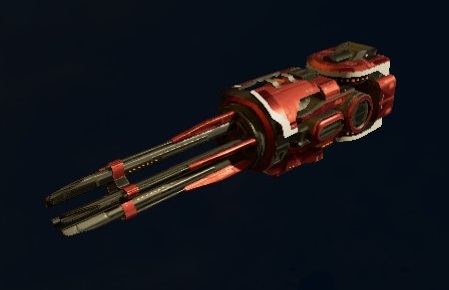Bolt Repeater
Bolt Repeater | |
|---|---|
 | |
| Type | Main Gun |
| Available From | ARG ANT PAR HOP TEL MIN ALI TEM TRI YAK RIP VIG QUE |
| Fitted To | Small and Medium ships |
| Role | Anti-Fighter |
| Required License | Military License (+10) |
In-game Description
The Bolt Repeater's average damage output and cooling make it an excellent choice for the indecisive military pilot. It is often considered the logical next step after having familiarised oneself with the Pulse Laser. Its prolonged bursts can easily tear apart targets of a similar size, but the projectiles are larger and move at a slower pace than Pulse Laser particles. This means that the pilot needs to have experience in gauging when to expend their burst, and when to let the weapon cool down and wait for a better opportunity. When facing off against this weapon, nimble ships may be able to dodge its stream of bullets by strafing and making spiral movements. Against capital ships, the Bolt Repeater is a suitable choice for destroying surface elements such as turrets and shields, though it struggles to leave a lasting impact on the ship's hull.
The modern-day Bolt Repeater is the result of a development path taken by Argon military scientists from old Mass Driver designs; a weapon which first saw use during the era of the Kha'ak threat. By stripping out the original weapon's ability to penetrate shields, and instead maximising the force of its continuous bullet output, they created a robust all-rounder that was soon adopted by the Federation's allies because of its sheer brutal efficiency.
The Mk2 variant uses even larger projectiles while maintaining the same projectile speed, resulting in a lower rate of fire but an increased level of overall trauma to the target's hull and shields.
Tactical Overview
The Bolt Repeater is the big brother of the Pulse Laser, offering more firepower at the cost of worse heat efficiency. The in-game description of the Bolt Repeaters' performance is very much on point.
As the description mentions, the Bolt Repeater doesn't perform as well in a dogfight as the Pulse Laser due to the slower projectile. Recommended is a boom-and-zoom approach where you pick a target from a distance, close in rapidly, unload your damage, and then boost away again before lining up for another strike. This gives the target little time to dodge while managing your heat.
Heat management is a genuine concern for this weapon, unlike the Pulse Laser, as it only offers about half the damage potential in a heat cycle. Firing discipline is a must; otherwise, you will struggle to do damage while you constantly overheat.
Interestingly, the Small Bolt Repeater is much more accurate than the Pulse Laser. In contrast, the Medium sized variant is slightly less accurate.
If you fit this weapon, your primary targets should be Heavy Fighters, Corvettes, and Gunboats. Light Fighters are rather hard to hit with the slow projectile unless you surprise them.
In the hands of an experienced pilot, the Bolt Repeater can rapidly destroy enemy S and M targets, using the increased firepower to its full potential.
Advantages:
- Small variant is very accurate
- Relatively high damage output
- Effective against most fighters and lesser protected mediums
- Available from most factions
Disadvantages:
- Slow projectiles make dogfighting more difficult
- Medium variant struggles at range due to reduced accuracy
- Heat management can be troublesome
Specifications
| Small Mk1 | Small Mk2 | Medium Mk1 | Medium Mk2 | |
| Damage Per Second | 111 | 220 | 198 | 387 |
| Sustained Damage Per Second | 92 | 179 | 155 | 297 |
| Damage Per Shot | 15 | 32 | 33 | 78 |
| Shots Per Second | 7.45/s | 6.9/s | 6/s | 4.97/s |
| Bust Clip Size | 18 | 20 | 21 | 24 |
| Burst Clip Shots Per Second | 12/s | 10/s | 8/s | 6/s |
| Burst Clip Reload Time | 1s | 1s | 1s | 1s |
| Projectile Speed | 2400m/s | 2400m/s | 1920m/s | 1920m/s |
| Maximum Range | 3000m | 3000m | 4800m | 4800m |
| Dispersion | 0.17° | 0.14° | 0.34° | 0.26° |
| Rotation Speed | 124°/s | 124°/s | 71°/s | 71°/s |
| Heat Generation Per Second | 335/s | 379/s | 450/s | 497/s |
| Heat Generation Per Shot | 45 | 55 | 75 | 100 |
| Heat Dissipation Per Second | 2000/s | 2000/s | 2000/s | 2000/s |
| Maximum Damage Until Overheat | 3345 | 5824 | 4422 | 7800 |
| Cooldown Delay When Overheating | 1.13s | 1.13s | 1.13s | 1.13s |
| Reactivates At After Overheating | 9500 | 9500 | 9500 | 9500 |
Construction Cost
Universal Build Method
| Small Mk1 | Small Mk2 | Medium Mk1 | Medium Mk2 | |
| Credits | 23.928 - 29.245 | 119.121 - 145.592 | 43.055 - 52.623 | 214-756 - 262.480 |
| Energy Cells | 5 | 10 | 5 | 10 |
| Weapon Components | 12 | 60 | 3 | 15 |
| Advanced Electronics | 1 | 5 | 8 | 40 |
Closed Loop Build Method
| Small Mk1 | Small Mk2 | Medium Mk1 | Medium Mk2 | |
| Credits | 23.928 - 29.245 | 119.121 - 145.592 | 43.055 - 52.623 | 214-756 - 262.480 |
| Energy Cells | 115 | 175 | 63 | 147 |
| Hull Parts | 15 | 75 | 7 | 37 |
| Claytronics | 2 | 13 | 1 | 6 |
Terran Build Method
| Small Mk1 | Small Mk2 | Medium Mk1 | Medium Mk2 | |
| Credits | 23.928 - 29.245 | 119.121 - 145.592 | 43.055 - 52.623 | 214-756 - 262.480 |
| Energy Cells | 50 | 100 | 50 | 100 |
| Metallic Microlattice | 44 | 96 | 53 | 145 |
| Silicon Carbide | 5 | 13 | 8 | 22 |
| Computronic Substrate | 2 | 13 | 4 | 24 |
